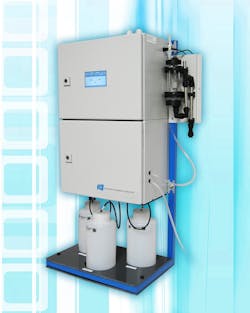Municipal water engineers concerned about Chromium VI in drinking water will find the CA6 Colorimetric Analyzer from Electro-Chemical Devices provides precise and dependable measurement to ensure compliance with local, state and federal drinking water safety standards.
The U.S. Environmental Protection Agency (EPA) describes chromium is an odorless and tasteless metallic element that is found naturally in rocks, plants, soil and volcanic dust, and animals. The most common forms of chromium that occur in natural waters in the environment are trivalent chromium (chromium III) and hexavalent chromium (chromium VI.)
Recognized as an essential human dietary element, chromium III is found in many vegetables, fruits, meats, grains, and yeast. chromium VI, however, while it occurs naturally in the environment from the erosion of natural chromium deposits, but it also can be produced by industrial processes. There are demonstrated instances of chromium VI being released into the environment by leakage, poor storage, or inadequate industrial waste disposal practices.
With chromium VI in the news again as a potential health risk, the U.S. EPA's assumes that a measurement of total chromium is 100 percent chromium VI, the more toxic form. If tap water from a public water system exceeds this federal standard, consumers will be notified.
ECD’s Model CA6 Colorimetric Analyzer is an on-line sequential sampling analyzer that is designed to monitor chromium VI in drinking water. It can be configured to measure chromium VI in three separate ranges: 0 to 1.0 mg/L, 0 to 10.0 mg/L or 0 to 50.0 mg/L
The CA6 Colorimetric Analyzer’s sequence of sampling, analysis and results processing is performed and repeated using colorimetric methods for high accuracy and reliability. This technology relies on an LED light source and a heated colorimetric cell designed for measuring trace amounts of manganese, iron and other analytes in water.
The CA6 analyzer is lightweight and easy to install. Weighing less than 40 pounds, it can be wall mounted or simply set on a bench using the optional bench top stand. After the sample, waste and reagent lines have been connected to the analyzer and provided with power, the CA6 will begin its preprogrammed analysis sequence.
The CA6 offers up to four separate channels (optional) each from a separate sample point. A simple, user-friendly menu structure and touchscreen interface makes it easy to access information or customize analyses.
Relying on photometric differential absorbance, the versatile CA6 Analyzer monitors chromium VI levels and over 20 other common parameters including: aluminum, iron, manganese, silica, nitrogen, iron and sulfate. It operates at a wide temperature range of 5-50°C and offers repeatability of ±2% on the absorbance value if the turbidity <80 NTU and drift of ±2% per month on the absorbance measurement.
With an intuitive, easy-to-use touch-screen display, the CA6 Analyzer shows the measured parameter, analyzer status, percent reagent volumes and the menu bar, which provides access to the run, display, program, service and help menus. It includes two alarm relay outputs and a 4-20 mA channel that connects with programmable logic controllers (PLC’s) or distributed control systems (DCS’s).
The rugged and reliable CA-6 features two separate compartments to isolate liquids and electronics and is enclosed in an epoxy powder coated, cold rolled steel cabinet. The liquids enclosure houses all the components necessary for sampling and reagent flow, mixing and reaction stages (sampling pump, reagent micro-pumps and colorimetric reaction cell).



